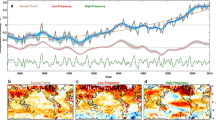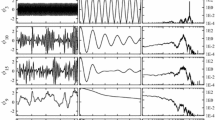Abstract
Results from a control integration and time-dependent greenhouse warming experiments performed with a coupled ocean-atmosphere model are analysed in terms of their signal-to-noise properties. The aim is to illustrate techniques for efficient description of the space-time evolution of signals and noise and to identify potentially useful components of a multivariate greenhouse-gas “fingerprint”. The three 100-year experiments analysed here simulate the response of the climate system to a step-function doubling of CO2 and to the time-dependent greenhouse-gas increases specified in Scenarios A (“Business as Usual”) and D (“Draconian Measures”) of the Intergovernmental Panel on Climate Change (IPCC). If signal and noise patterns are highly similar, the separation of the signal from the natural variability noise is difficult. We use the pattern correlation between the dominant Empirical Orthogonal Functions (EOFs) of the control run and the Scenario A experiment as a measure of the similarity of signal and noise patterns. The EOF 1 patterns of signal and noise are least similar for near-surface temperature and the vertical structure of zonal winds, and are most similar for sea level pressure (SLP). The dominant signal and noise modes of precipitable water and stratospheric/tropospheric temperature contrasts show considerable pattern similarity. Despite the differences in forcing history, a highly similar EOF 1 surface temperature response pattern is found in all three greenhouse warming experiments. A large part of this similarity is due to a common land-sea contrast component of the signal. To determine the degree to which the signal is contaminated by the natural variability (and/or drift) of the control run, we project the Scenario A data onto EOFs 1 and 2 of the control. Signal contamination by the EOF 1 and 2 modes of the noise is lowest for near-surface temperature, a situation favorable for detection. The signals for precipitable water, SLP, and the vertical structure of zonal temperature and zonal winds are significantly contaminated by the dominant noise modes. We use cumulative explained spatial variance, principal component time series, and projections onto EOFs in order to investigate the time evolution of the dominant signal and noise modes. In the case of near-surface temperature, a single pattern emerges as the dominant signal component in the second half of the Scenario A experiment. The projections onto EOFs 1 and 2 of the control run indicate that Scenario D has a large common variability and/or drift component with the control run. This common component is also apparent between years 30 and 50 of the Scenario A experiment, but is small in the 2 × CO2 integration. The trajectories of the dominant Scenario A and control run modes evolve differently, regardless of the basis vectors chosen for projection, thus making it feasible to separate signal and noise within the first two decades of the experiments. For Scenario D it may not be possible to discriminate between the dominant signal and noise modes until the final 2–3 decades of the 100-year integration.
Similar content being viewed by others
References
Barnett TP (1986) Detection of changes in the global tropospheric temperature field induced by greenhouse gases. J Geophys Res 91:6659–6668
Barnett TP, Schlesinger ME, Jiang X (1991) On greenhouse-gas detection strategies. In: Schlesinger ME (ed) Greenhouse-gasinduced climatic change: a critical appraisal of simulations and observations. Elsevier, Amsterdam, pp 537–558
Barnett TP, Schlesinger ME (1987) Detecting changes in global climate induced by greenhouse gases. J Geophys Res 92:14772–14780
Cess RD, Potter GL, Blanchet JP, Boer GJ, Ghan SJ, Kiehl JT, Le Treut H, Li ZX, Liang XZ, Mitchell JFB, Morcrette JJ, Randall DA, Riches MR, Roeckner E, Schlese U, Slingo A, Taylor KE, Washington WM, Wetherald RT, Yagai I (1989) Interpretation of cloud climate feedback as produced by 14 atmospheric general circulation models. Science 245:513–516
Cubasch U, Hasselmann K, Hock H, Maier-Reimer E, Mikolajewicz U, Sauter BD, Sausen R (1992) Time-dependent greenhouse warming computations with a coupled ocean-atmosphere model. Clim Dyn 8:55–69
Cubasch U, Santer BD, Hellbach A, Hegerl G, Höck H, Maier-Reimer E, Mikolajewicz U, Stössel A, Voss R (1994) Monte Carlo climate change forecasts with a global coupled ocean-atmosphere model. Clim Dyn (in press)
Hasselmann K (1993) Optimal fingerprints for the detection of time dependent climate change. J Clim (accepted)
Hasselmann K, Sausen R, Maier-Reimer E, Voss R (1993) On the cold start problem in transient simulations with coupled ocean-atmosphere models. Clim Dyn (in press)
Houghton IT, Jenkins GJ, Ephraums JJ (1990) Climate change. The IPCC scientific assessment. Cambridge University Press, Cambridge
James IN, James PM (1989) Ultra-low-frequency variability in a simple atmospheric circulation model. Nature 342:53–55
Karoly DJ (1987) Southern Hemisphere temperature trends: a possible greenhouse gas effect? Geophys Res Lett 14:1139–1141
Karoly DJ (1989) Northern Hemisphere temperature trends: a possible greenhouse gas effect? Geophys Res Lett 16:465–468
Lautenschlager M, Herterich K (1990) Atmospheric response to ice age conditions - climatology near the earth's surface. J Geophys Res 95:22547–22557
Liu Q, Schuurmanns CJE (1990) The correlation of tropospheric and stratospheric temperatures and its effect on the detection of climate changes. Geophys Res Lett 17:1085–1088
MacCracken MC, Moses H (1982) The first detection of carbon dioxide effects: workshop summary, 8–10 June 1981, Harpers Ferry, West Virginia. Bull Am Meteorol Soc 63:1164–1178
Madden RA, Ramanathan V (1980) Detecting climate change due to increasing carbon dioxide. Science 209:763–768
Maier-Reimer E, Hasselmann K (1987) Transport and storage of CO2 in the ocean – an inorganic ocean-circulation carbon cycle model. Clim Dyn 2:63–90
Maier-Reimer E, Mikolajewicz U (1989) Experiments with an OGCM on the cause of the Younger Dryas. In: Ayala-Castanares A, Wooster W, Yanez-Arancibia A (eds) Oceanography 1988. UNAM Press, Mexico, pp 87–100
Maier-Reimer E, Mikolajewicz U, Hasselmann K (1993) On the sensitivity of the global ocean circulation to changes in the surface heat flux forcing. J Phys Oceanogr 23:731–757
Manabe S, Stouffer RJ, Spelman MJ, Bryan K (1991) Transient responses of a coupled ocean-atmosphere model to gradual changes of atmospheric CO2. Part 1: annual mean response. J Clim 4:785–818
Mikolajewicz U, Maier-Reimer E (1990) Internal secular variability in an ocean general circulation model. Clim Dyn 4:145–156
Mikolajewicz U, Santer BD, Maier-Reimer E (1990) Ocean response to greenhouse warming. Nature 345:589–593
Mikolajewicz U, Maier-Reimer E, Barnett TP (1993) Acoustic detection of greenhouse-induced climate changes in the presence of slow fluctuations of the thermohaline circulation. J Phys Oceanogr 23:1099–1109
Preisendorfer RW (1988) Principal component analysis in meteorology and oceanography. Developments in Atmospheric Science 17. Elsevier, Amsterdam
Richman MB, Lamb PJ (1985) Climatic pattern analysis of threeand seven-day summer rainfall in the central United States: some methodological considerations and a regionalization. J Clim Appl Met 24:1325–1343
Roeckner E, Dümenil L, Kirk E, Lunkeit F, Ponater M, Rockel B, Sausen R, Schlese U (1989) The Hamburg version of the ECMWF model (ECHAM). In: Boer GF (ed) Research activities in atmospheric and oceanic modelling. CAS/JSC Working Group on Numerical Experimentation 13:7.1–7.4 WMO Technical Document 322, Geneva
Santer BD, Wigley TML, Schlesinger ME, Jones PD (1991) Multivariate methods for the detection of greenhouse-gas-induced climate change. In: Schlesinger ME (ed) Greenhouse-gas-induced climatic change: a critical appraisal of simulations and observations. Elsevier, Amsterdam, pp 511–536
Santer BD, Wigley TML, Jones PD (1993) Correlation methods in fingerprint detection studies. Clim Dyn 8:265–276
Sausen R, Barthel K, Hasselmann K (1988) Coupled ocean-atmosphere models with flux corrections. Clim Dyn 2:154–163
Schlesinger ME, Mitchell JFB (1987) Climate model simulations of the equilibrium climatic response to increased carbon dioxide. Rev Geophys 25:760–798
Stouffer RJ, Manabe S, Bryan K (1989) Interhemispheric asymmetry in climate response to a gradual increase of atmospheric CO2. Nature 342:660–662
Washington WM, Meehl GA (1989) Climate sensitivity due to increased CO2: experiments with a coupled atmosphere and ocean general circulation model. Clim Dyn 4:1–38
Wigley TML, Barnett TP (1990) Detection of the greenhouse effect in the observations. In: Houghton JT, Jenkins GJ, Ephraums JJ (eds) Climate change. The IPCC scientific assessment. Cambridge University Press, Cambridge, pp 239–256
Wigley TML, Jones PD (1981) Detecting CO2-induced climatic change. Nature 292:205–208
Author information
Authors and Affiliations
Rights and permissions
About this article
Cite this article
Santer, B.D., Brüggemann, W., Cubasch, U. et al. Signal-to-noise analysis of time-dependent greenhouse warming experiments. Climate Dynamics 9, 267–285 (1994). https://doi.org/10.1007/BF00204743
Received:
Accepted:
Issue Date:
DOI: https://doi.org/10.1007/BF00204743




